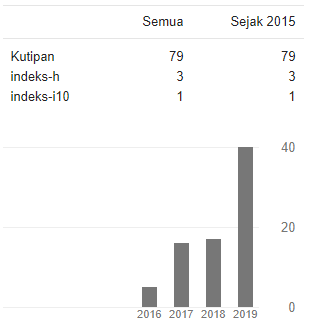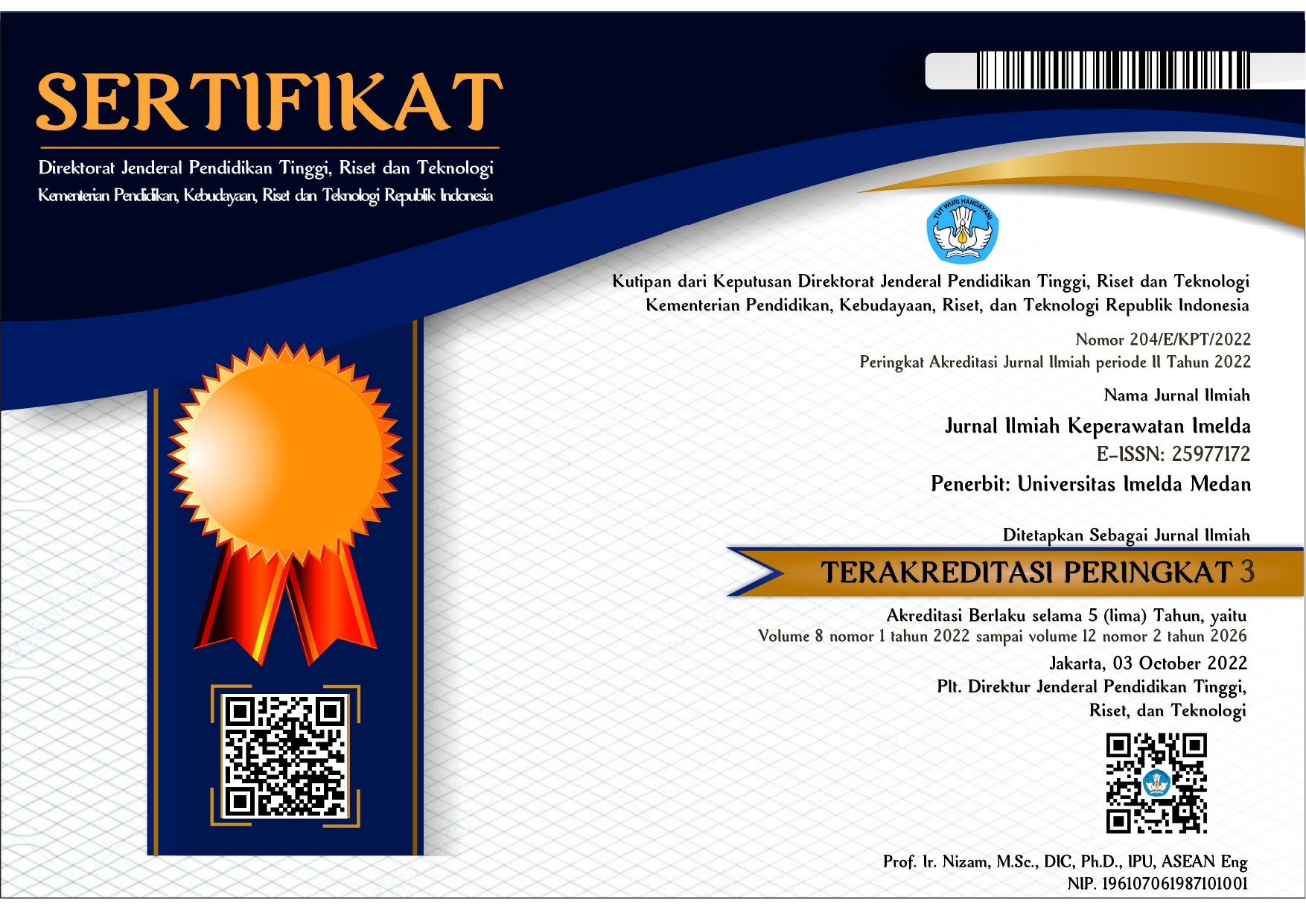HUBUNGAN SELF-MANAGEMENT DENGAN KUALITAS HIDUP PADA PASIEN PASCA STROKE NON HEMORAGIK DI RUMAH SAKIT UMUM IMELDA PEKERJA INDONESIA MEDAN TAHUN 2021
DOI:
https://doi.org/10.52943/jikeperawatan.v8i1.683Keywords:
Post Hemorrhagic Stroke, Self-Management, Quality of LifeAbstract
Stroke or Cerebro Vascular Accident (CVA) is a vocal or global functional brain disorder (neurological deficit) that lasts more than 24 hours caused by a neotraumatic cerebral blood circulation disorder resulting in a lack of blood and oxygen flow to the brain. as a result of blockage, narrowing or rupture of blood vessels, usually affects patients aged 40-80 years. The symptoms of stroke include headaches, loss of balance, visual disturbances, loss of the ability to speak clearly or the ability to understand other people's speech, and impaired smell. The purpose of this study was to determine the relationship between self-management and quality of life in postoperative patients. non-hemorrhagic stroke. This research was conducted at Imelda Indonesian Workers General Hospital Medan. The population in this study were 48 who were taken using accidental sampling. Data collection using a questionnaire and analyzed by Chi-square test. The results showed that p value = 0.005 < 0.05. It means that there is a relationship between self-management and quality of life in non-hemorrhagic post-stroke patients at Imelda Indonesian Workers General Hospital in Medan. Based on the results of the study, it can be concluded that the better the treatment and self-management in post-stroke patients, the lower the incidence of recurrent stroke.
Downloads
References
Anglina P. 2010. Hubungan Self Managemen Dengan Kualitas Hidup Pasien Pasca Stroke Di Puskesmas Pisangan Ciputat. Vol. 53, Universitas Islam Negri Syarif Hidayatullah. Universitas Islam Negri Syarif Hidayatullah., 2013.
Bakara Dan Warsito. Dennis M. Stroke: Prasccikal. Engl J Med. 2016.
Bogger. 2014. Self Manajement Folling Stroke : Koncet And Measurement. Disertai Program Doctor Filosofi Universitas Southantomtom
Diani. 2015. Handicap N Quality Of Line After Stroke. In Long Term Effect Of Stroke. Newyork: Marcel Dekker: 2005.
Pletcher. Dan Sintia. 2015. Stroke In Indonesia: A First Large Prospective Hospital-Based Study Of Acute Stroke In 28 Hospitals In Indonesia.
Guan. 2018. Pattern Of Stroke In Type 2 Diabetic Subjects Versus Non-Diabetic Subjects.
Gyfney. 2008. Debette S. Genetic Risk Factors For Ischemic And Hemorrhagic Stroke. Current Cardiology Reports. Carter Bl.
Hastuti. 2014. Blood Pressure In Relation To The Incidence Of Cerebral Infarction And Intracerebral Hemorrhage – Hypertensive Hemorrhage.
Jaus. 2016. . Vital Signs: Recent Trends In Stroke Death Rates — United States, 2000–2015. Mmwr Morb Mortal Wkly Rep.
Mardiah Dan Junaidi. 2019. Incidence And 10-Year Survival Of Intracerebral Hemorrhage In A Population-Based Registry. Stroke.
Marlina. 2019. Worldwide Stroke Incidence And Early Case Fatality Reported In 56 Population-Based Studies: A Systematic Review. The Lancet Neurology.
Nabyi. 2012. Blood Pressure In Relation To The Incidence Of Cerebral Infarction And Intracerebral Hemorrhage - Hypertensive Hemorrhage: Debated Nomenclature Is Still Relevant. Stroke.
Nastiti. 2011. A First Large Prospective Hospital-Based Study Of Acute Stroke In 28 Hospitals In Indonesia. J Clin Neurosci.
Nurwahyuni. 2000. Ischemic Stroke In The Young: Clinical Features And Long-Term Prognosis. Neurology.
Padila. 2012. Zafar A, Shahid Sk, Siddiqui M, Khan Fs. Pattern Of Stroke In Type 2 Diabetic Subjects Versus Non-Diabetic Subjects. J Ayub Med Coll Abbottabad.
Pudiastuti. D. Dan Junaidi. 2019. Penyakit-Penyakit Mematikan. Nuha Medika. Yokyakarta.
Ramadhani Pirnomo, 2016. Analisis Faktor-Faktor Yang Mempengaruhi Kejadian Stroke Pada Pasien Pasca Stroke.E Jurnal Stikes.Vol. 12.No. 24. Pp. 11-31.
Accessed In 5 November 2017.Stein M, Misselwitz B, Hamann Gf, Scharbrodt W, Schummer Di, Oertel Mf. Intracerebral Hemorrhage In The Very Old: Future Demographic Trends Of An Aging Population. Stroke.
Riwan R. 2019. Terhadap Kejadian Strok Dipadang Kota Sidempuan. Tahun 2017. Jurnal Pengembangan Edukasional.
Santoso. 2018. Zia E, Hedblad B, Pessahrasmussen H, Berglund G, Janzon L, Engström G. Blood Pressure In Relation To The Incidence Of Cerebral Infarction And Intracerebral Hemorrhage - Hypertensive Hemorrhage: Debated Nomenclature Is Still Relevant. Stroke.
Silvia. 2011. Sacco S, Marini C, Toni D, Olivieri L, Carolei A. Incidence And 10-Year Survival Of Intracerebral Hemorrhage In A Population-Based Registry. Stroke.
Susilawati. 2018. Mohammad Y, Qureshi A. Blood Pressure Management In Intracerebral Hemorrhage. Semin Neurol.
Wijaya Dan Mariza. 2013. Stein M, Misselwitz B, Hamann Gf, Scharbrodt W, Schummer Di, Oertel Mf. Intracerebral Hemorrhage In The Very Old: Future Demographic Trends Of An Aging Population. Stroke.









